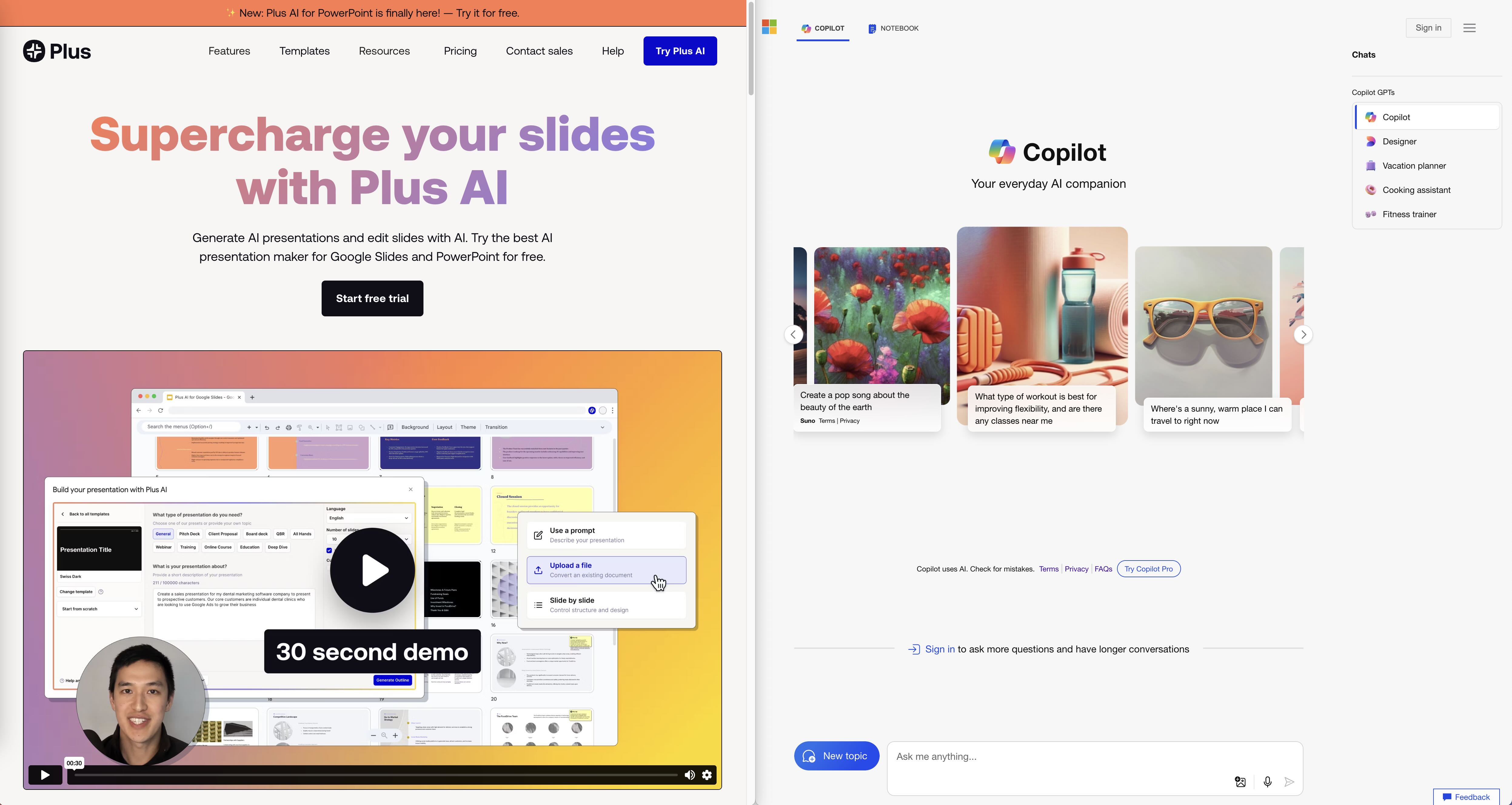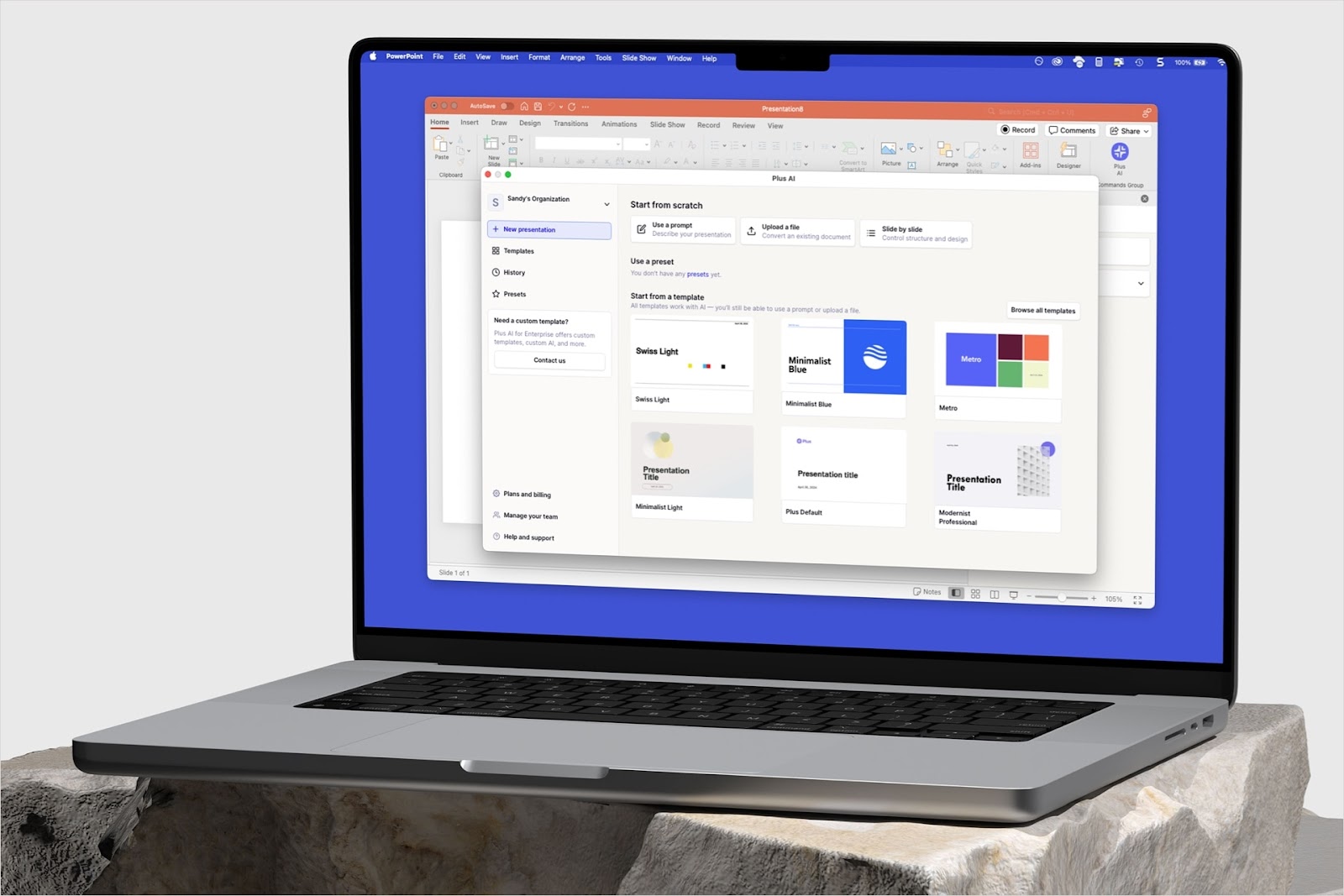Whether you like it or not, making presentations is an important part of the professional and academic worlds. It is also a very time-consuming task. Luckily, many AI presentation tools will cut hours off the work required to build a presentation. Read about the best of the tools here.
This might leave you feeling overwhelmed with choices when you need to pick the best tool for you. To help narrow down the options, we have pulled together a guide that highlights the 10 features to look out for in an AI presentation tool to help you find the perfect tool for you.
{toc}
Feature 1: Seamless integration with your existing tools
Your company or school probably already has a preferred presentation tool like Google Slides, Microsoft PowerPoint, or Canva. This is worth taking into consideration when choosing an AI presentation tool because if your tool doesn't work with your existing presentation tool, you'll have to learn a lot of new features and convince your teams and clients to switch tools as well.
Integration with existing tools has been handled along a spectrum:
- Built into existing presentation apps - tools such as Plus AI (see below) are built directly into Google Slides, which allows users to leverage AI in the tools you already use. This involves the least friction with current workflows.

- Standalone with export to existing tool - while users have to generate the presentations in a separate tool, they can export to a common format. The exports remove some friction, however this removes the ability to edit the presentations on an ongoing basis using AI.
- Standalone without export to existing tools - this setup allows the creators of AI presentation tools to provide a unique experience, but requires users to adopt a new presentation tool, which introduces a great deal of friction.
Feature 2: Great user interface
A great user interface makes a tool easier to use. For productivity tools like an AI presentation maker, this means maximizing the productivity gain from using the tool. When you’re exploring the different tools you should make sure that the user interface makes it easy to perform the actions that you want from the AI presentation maker. The examples below illustrate examples of great user interfaces.
Gamma’s feature selector
Gamma makes it easy to get started by asking the user simple step-by-step questions about what they want to generate.

Plus AI’s editing sidebar
The Plus AI sidebar lets users pick and choose from AI-powered editing features right within Google Slides while working on their presentations.

Feature 3: Real slide design
Many AI presentation makers generate slides exclusively in text + image formats, often with a lot of text on each slide. Below is an example of this in a presentation generated by Tome.

Long paragraphs and sentences like this are helpful for content that is read but not presented. The more common expectation, particularly for professional presentations, is that slides use bullets and structured layoutsto make them easily digestible.
When you choose an AI presentation maker, you should consider whether the tool generates slides in a design and format that you are able to use without much editing, such as the features below with Plus AI.

Feature 4: Content editing and rewriting
The best AI presentation makers go beyond just generating presentations and stay with you to “co-write” and revise the newly generated slides or help you edit existing ones. Editing features to look out for include:
- Rewriting - a big part of slide editing involves adjusting the text in the presentation. Often you might know what you want to do with the text but end up spending a lot of time getting it just right. With a rewriting feature, you can simply tell the AI to “make your text more concise,” and it is done in seconds. Plus AI and Tome both include rewriting features.
- Remixing - half the battle with making a good slide is to structure it. Remixing features within AI presentation tools let you remix content into any suitable format on a slide.
Feature 5: Customization and branding
Most companies or schools have a brand identity, whether it’s been formalized through a brand guide or it is just implied. This branding is generally applied across all presentations in a company and comes in the form of, e.g., color schemes, logos, and fonts.
You should keep this in mind when choosing your AI presentation tools - if you are using it professionally, you should prioritize the ability to customize the presentation. The standalone tools, in particular, have limited customization options, which means it is difficult to generate brand-appropriate presentations with them.
The tools built within Google Slides typically offer the best ability to brand presentations using your existing slide templates. Plus AI can also help you create new slide templates based on your company's colors and logo using the Design feature.

Feature 6: Collaboration
Creating good presentations often involves collaboration. Make sure that your AI presentation tool includes the ability to collaborate with your team. While most of the tools in the market do include the ability to collaborate on the presentation, the number of users that can interact with the presentations is often limited by which tier of the product that you use.
This will not be the case if you work with an AI presentation tool that is built into an existing presentation app. For example, if you use Plus AI within Google Slides, anyone on your team will be able to collaborate and interact with the presentation in Google Slides.
Feature 7: Data security and privacy
Data security and privacy are key when adopting any kind of software. This may be especially important if you are using AI presentation software to generate presentations for work.
You can check whether a tool lives up to your data security and privacy requirements by reading the “Privacy Policy” or “Security” section, which is usually found at the bottom of the home page. Things to look out for:
- Does the tool use data encryption to protect your information?
- Do they have policies around who can access your data?
- Does the software have compliance and security accreditations, such as SOC 2 Type II?
Feature 8: Multilingual support
If you plan to generate presentations in languages other than English, make sure to check whether the AI can understand and generate content in any language you will be using. Most of the main AI presentation tools support the majority of languages, but you should check before adopting a tool.
Feature 9: Customer support
Most AI presentation tools are new, and so is the technology. This means that users may be unfamiliar with how to use the tools, and the tools might contain more bugs than more established products. This makes good customer support all the more important.
Feature 10: AI copilot
Last but not least, your tool should understand that AI can’t do the work you can do, but it can make you 10x faster.
AI is amazing, and it has the ability to significantly improve productivity. However, generative AI cannot replace humans, and the best AI presentation makers understand this. Make sure you choose a tool that “co-writes” presentations with you rather than attempting to create a final product.
Plus AI was built around the idea that AI drafts + human finishing touches is a winning formula for professional, creative work. This means that the AI can help you get over the “blank page problem”, provide you with tips, and let you edit slides faster, but only you can add the additional context that makes it a great presentation.







